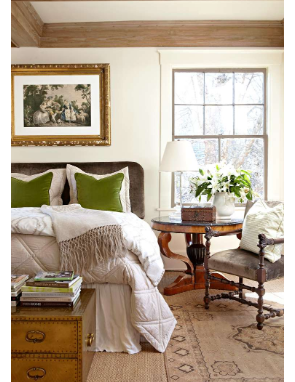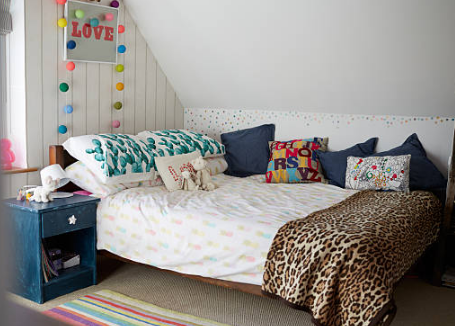
15 Kitchen Ideas to Maximize Space and Style
July 29, 2024
Copper Backsplashes Are in Vogue: What You Need to Know About Metal Kitchen Décor
August 3, 2024At some point in recent history, bedrooms have become multifunctional spaces: they are a playroom for children, a preferred place to work from home, and an ideal TV hangout, because everyone knows that beds are more comfortable than sofas. We want our bedrooms to be equipped with practical storage and at the same time (somehow) feel peaceful. If the bedroom were our staff, they would have asked for a raise because we had made them far beyond their job description.
Whether your space is large or small, figuring out how to arrange bedroom furniture to accommodate all of these roles can feel like a tricky puzzle with too many factors to consider. But with the help of home experts and smart design strategies, we’ve designed 12 layouts for the master bedroom, guest bedroom, and children’s bedroom to maximize space and comfort.
1. Feng Shui Bedroom

Although Feng Shui is achieved through the placement of furniture, it is mostly your feelings. You will immediately feel the harmony, and in the sleeping space this emotional shift begins in your bed: place your frame in a “command position” with a wall or solid headboard behind it, space to crawl on either side, and a view of the door, but not directly facing it. Create visual balance with symmetrical accessories: pairs of bedside tables, lamps, and pillows.
2. Small Bedroom

If your sleeping area is tight, look for simple solutions. “Living small means taking advantage of vertical space,” says Anita Yokota, a family therapist. Her go-to moves: installing attractive, all-purpose wall hooks and hanging plants and lights from the ceiling to free up the top of dressers and bedside tables. Choose furniture that has a dual function, such as a headboard with shelves, a bed with drawers, or a bookshelf instead of a bedside table. If your bedroom is also an office, “change a small table on one side of the bed”, suggests designer Emilie Munroe. “It’s stylish and functional. ”
3. Large Bedrooms

For furniture arrangements for large bedrooms, consider zoning. Designer Linda Hayslett advises: “Decide where the bed is located first, and then think about how to experience the rest of the space. Don’t limit yourself to a reading corner or lounge area. Why not create a home office, a yoga spot, or a craft corner?” Designed for this,” Yokota said. Each area should be an island with its own accessories such as carpets and lights. “Otherwise they’ll feel like an afterthought,” Monroe warned. A consistent color palette will unify the space.
4. Furnished Bedrooms in Front of the Window

How you furnish your bedroom usually depends on the layout of the room. If the best position for your bed is on a wall with windows, like designer Beth Barden’s bedroom (pictured above), then create “architecture” behind it: think of the bed’s pillars and sturdy headboard, not the window, the focal point. The right windows can both serve as a beautiful barrier to the outside world and allow natural light to enter.
5. Asymmetrical Bedrooms

There is no rule that says that your bed must be in the center of the wall. The arrangement of the furniture in the bedroom focused on one side of the space opens up the flow of traffic and leaves more room for personalization. Here, the asymmetrical layout gives the small bedroom a sense of spaciousness, creating visual space for bold décor such as patterned headboards, fringed curtains, and tiered rugs. Symmetrical details, such as a pair of yellow lamps and bedside tables, prevent this arrangement from looking unbalanced.
6. Remodel Your Bedroom

Combine existing furniture with beloved antique and formal furniture to add personality to your bedroom. In this lavishly furnished bedroom, the gilded frame glistens on the luxurious velvet headboard, and the living room chairs are relaxing. The vintage dining table serves as a bedside table, while the antique suitcase doubles as a footstand. Pull out antique furniture or accessories from more communal living areas and place them in places that are normally reserved for traditional bedroom furniture. This arrangement will work as long as they serve their purpose and please your eyes.
7. Bedroom with Extra Seating

Create a peaceful retreat with bedroom furnishings, including comfortable chairs and benches. Your options are plentiful: tuck chairs and floor lamps into corners to make room for reading, or move an upholstered bench to the foot of the bed as a place to put on and take off your shoes. Place a pair of skirted chairs near the window so you can soak up the afternoon sun, and cover the footrest bench with complementary fabrics for a coordinated look. Don’t add chairs to fill the space, though – only add the seats you’re actually using.
8. Awkwardly Laid out Bedrooms

Windows, doorways, closets – these standard bedroom features can disrupt the flow of space, create an unnatural layout, and create a challenging furniture arrangement. But with a few creative tweaks, you can overcome an awkward configuration, such as in this bedroom with multiple windows and limited wall space. These clever homeowners expanded the footprint of the small space by centering the twin beds in front of a pair of windows and accommodating the two beds with a single nightstand. The open design of these modern headboards ensures that natural light can flow in, while a bamboo ladder balances the bed’s soaring height.
9. Balance the Bedroom with Different Lighting

Don’t ignore the lights. Think of table lamps, chandeliers, and sconces as jewels that make your furniture sparkle. If you have space, you can place a tabletop on either side of the bed and place a light source, whether it’s a wall-mounted candle holder or a pair of lights. There’s no need to limit yourself to the expected bedside table: in this tranquil space, homeowners have maximized functionality and storage space by providing a small dresser on either side of the upholstered bed and a table that doubles as a computer station and utility table. The chandelier illuminates the entire space overhead and helps center the room.
10. Bedrooms with Multiple Beds

Close proximity requires clever bedroom furnishings. In this carefree beach bedroom, bunk beds are stacked on top of each other to accommodate two sleepers in a small space. With a wall-mounted lantern light at one end and a TV at the other, these beds turn into a multi-purpose lounge area, perfect for reading, napping, or streaming. Baskets under the lower bunks provide easy-to-access storage space to store clothes and gear where they don’t obstruct traffic routes, which is essential for small spaces serving children or guests.
11. Relaxing Bedrooms

Use the overlooked wall space under the window to create a place to relax (or talk). Install a bench with comfortable cushions and pillows that provide both seating and storage while balancing the empty nooks and the high headboard next to it. Doors that open outwards make this side of the room a natural place to hang out, and the colors of the plush rug are inspired by the other textiles in the room, helping to define the space.
12. Double Bedrooms

With thoughtful planning, bedroom furniture is arranged to meet the needs of sleep and play. Imagine a library with shelves full of flipped books, or a closet full of scrapbook supplies. This homeowner has outfitted her bedroom with creative pursuits by setting up easels and art supplies near the window and moving the bed to the other side of the room. Console tables, artwork, and empty frames fill in the gaps, connecting the sleeping area to the sun-drenched studio.



